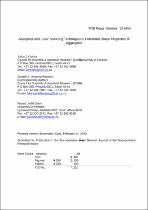 ResearchSpace
ResearchSpace
Analytical and laser scanning techniques to determine shape properties of mineral aggregates
JavaScript is disabled for your browser. Some features of this site may not work without it.
- ResearchSpace
- →
- Research Publications/Outputs
- →
- Conference Publications
- →
- View Item
| dc.contributor.author |
Komba, Julius J

|
|
| dc.contributor.author |
Anochie-Boateng, Joseph

|
|
| dc.contributor.author |
Steyn, WJvdM

|
|
| dc.date.accessioned | 2013-04-11T10:23:39Z | |
| dc.date.available | 2013-04-11T10:23:39Z | |
| dc.date.issued | 2013-01 | |
| dc.identifier.citation | Komba J, Anochie-Boateng JK and Steyn WJvdM. 2013. Analytical and laser scanning techniques to determine shape properties of mineral aggregates. In: Transportation Research Board 92nd Annual Meeting, Washington, 13-17 January 2013 | en_US |
| dc.identifier.uri | http://amonline.trb.org/2ve72n/2ve72n/1 | |
| dc.identifier.uri | http://pubsindex.trb.org/ | |
| dc.identifier.uri | http://hdl.handle.net/10204/6653 | |
| dc.description | The paper was presented at the Transportation Research Board 92nd Annual Meeting, Washington, 13-17 January 2013. | en_US |
| dc.description.abstract | The fundamental shape attributes of aggregates used in pavements i.e., form, angularity, and surface texture have not been accurately quantified historically, because of their irregular and non-ideal shapes. This paper presents selected results using a laser-based scanning technique to determine the form of aggregates used in construction of pavements in South Africa. A three-dimensional (3-D) laser scanning system was used to scan aggregate materials from different sources, and the data were processed to reconstruct 3-D models of the aggregate particles. The models were further analyzed to determine the form properties. In this paper, two analysis approaches, based on aggregate physical properties and spherical harmonic analysis, were employed to determine the aggregate form indices. The aggregate form indices obtained from the physical aggregate properties were compared with the form indices computed based on the spherical harmonic analysis. The indices based on the physical properties include sphericity computed from the surface area and volume, sphericity computed from three orthogonal dimensions, and flat and elongated ratio computed from the longest and shortest dimensions of an aggregate particle. Good correlations were observed between the form indices obtained from the aggregate physical properties, and the spherical harmonic form index. It is concluded that laser scanning technique could be employed to better quantify the form properties of aggregate materials used in pavements. | en_US |
| dc.language.iso | en | en_US |
| dc.publisher | Transportation Research Board | en_US |
| dc.relation.ispartofseries | Workflow;10357 | |
| dc.subject | Pavement construction | en_US |
| dc.subject | South African pavements | en_US |
| dc.subject | Laser scanning techniques | en_US |
| dc.title | Analytical and laser scanning techniques to determine shape properties of mineral aggregates | en_US |
| dc.type | Conference Presentation | en_US |
| dc.identifier.apacitation | Komba, J. J., Anochie-Boateng, J., & Steyn, W. (2013). Analytical and laser scanning techniques to determine shape properties of mineral aggregates. Transportation Research Board. http://hdl.handle.net/10204/6653 | en_ZA |
| dc.identifier.chicagocitation | Komba, Julius J, Joseph Anochie-Boateng, and WJvdM Steyn. "Analytical and laser scanning techniques to determine shape properties of mineral aggregates." (2013): http://hdl.handle.net/10204/6653 | en_ZA |
| dc.identifier.vancouvercitation | Komba JJ, Anochie-Boateng J, Steyn W, Analytical and laser scanning techniques to determine shape properties of mineral aggregates; Transportation Research Board; 2013. http://hdl.handle.net/10204/6653 . | en_ZA |
| dc.identifier.ris | TY - Conference Presentation AU - Komba, Julius J AU - Anochie-Boateng, Joseph AU - Steyn, WJvdM AB - The fundamental shape attributes of aggregates used in pavements i.e., form, angularity, and surface texture have not been accurately quantified historically, because of their irregular and non-ideal shapes. This paper presents selected results using a laser-based scanning technique to determine the form of aggregates used in construction of pavements in South Africa. A three-dimensional (3-D) laser scanning system was used to scan aggregate materials from different sources, and the data were processed to reconstruct 3-D models of the aggregate particles. The models were further analyzed to determine the form properties. In this paper, two analysis approaches, based on aggregate physical properties and spherical harmonic analysis, were employed to determine the aggregate form indices. The aggregate form indices obtained from the physical aggregate properties were compared with the form indices computed based on the spherical harmonic analysis. The indices based on the physical properties include sphericity computed from the surface area and volume, sphericity computed from three orthogonal dimensions, and flat and elongated ratio computed from the longest and shortest dimensions of an aggregate particle. Good correlations were observed between the form indices obtained from the aggregate physical properties, and the spherical harmonic form index. It is concluded that laser scanning technique could be employed to better quantify the form properties of aggregate materials used in pavements. DA - 2013-01 DB - ResearchSpace DP - CSIR KW - Pavement construction KW - South African pavements KW - Laser scanning techniques LK - https://researchspace.csir.co.za PY - 2013 T1 - Analytical and laser scanning techniques to determine shape properties of mineral aggregates TI - Analytical and laser scanning techniques to determine shape properties of mineral aggregates UR - http://hdl.handle.net/10204/6653 ER - | en_ZA |





